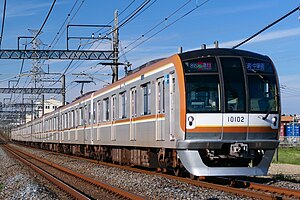
The Minatomirai 21 Line, commonly known as the Minatomirai Line, is a subway line in Yokohama, Japan that runs from Yokohama Station to Motomachi-Chūkagai Station through the Minatomirai 21 business district. The line opened in 2004 and is operated by the Yokohama Minatomirai Railway Company.

The Tōyoko Line is a major railway line connecting Tokyo (Shibuya) to Yokohama. The line is owned and operated by the private railway operator Tokyu Corporation. The name of the line, Tōyoko (東横), is a combination of the first characters of Tōkyō (東京) and Yokohama (横浜), and is the mainline of the Tokyu network. The section between Den-en-chofu and Hiyoshi Station is a quadruple track corridor with the Tōkyū Meguro Line.

The Tokyo Metro Hibiya Line is a subway line in Tokyo, Japan, owned and operated by Tokyo Metro. The line was named after the Hibiya area in Chiyoda's Yurakucho district, under which it passes. On maps, diagrams and signboards, the line is shown using the color silver, and its stations are given numbers using the letter "H".

The Tokyo Metro Hanzōmon Line is a subway line in Tokyo, Japan, owned and operated by Tokyo Metro.

The Tokyo Metro Yurakucho Line is a subway line in Japan owned and operated by Tokyo Metro. The line connects Wakōshi Station in Wakō, Saitama and Shin-Kiba Station in Kōtō, Tokyo. On maps, diagrams and signboards, the line is shown using the color "gold", and its stations are given numbers using the letter "Y".
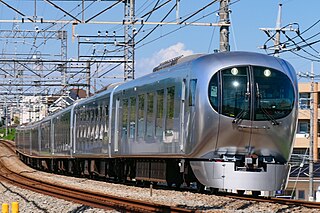
The Seibu Ikebukuro Line is a railway line of the Japanese private railway operator Seibu Railway. It originates at Ikebukuro Station, a large railway junction in north-western Tokyo, extending to northwest suburbs as far as Tokorozawa, Saitama, and nominally terminates at Agano Station.

The Tobu Tojo Line is a 75.0 km (46.6 mi) suburban railway line in Japan which runs from Ikebukuro Station in Toshima, Tokyo to Yorii Station in Yorii, Saitama, operated by the private railway operator Tobu Railway. Its official name is the Tobu Tojo Main Line, but it is referred to as Tobu Tojo Line on Tobu signage and publicity information.
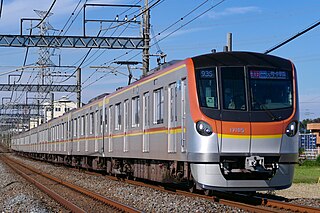
The Tokyo Metro Fukutoshin Line, formally the No. 13 Fukutoshin Line, is a 20.2-kilometer (12.6 mi) subway line operated by Tokyo Metro in west-central Tokyo and Wako, Saitama, Japan. The newest line in the Tokyo subway network, it opened in stages between 1994 and 2008. On average, the Fukutoshin Line carried 362,654 passengers daily in 2017, the lowest of all Tokyo Metro lines and roughly one third of its sister Tokyo Metro Yūrakuchō Line (1,124,478).

The Tobu 50000 series is a DC electric multiple unit (EMU) commuter train type operated by the private railway operator Tobu Railway in Japan since March 2005, manufactured by Hitachi to its "A-train" concept. The trains represent the first use of aluminium body cars on Tobu commuter trains. They are also the first Tobu trains to feature bilingual automated passenger announcements.

The Tokyo Metro 07 series is an electric multiple unit (EMU) train type operated by Tokyo Metro in Tokyo, Japan. Introduced into service in 1993, a total of six 10-car sets were manufactured by Kawasaki Heavy Industries and Nippon Sharyo between 1993 and 1994 for use on the Tokyo Metro Yūrakuchō Line. From 2006, the sets were permanently transferred to the Tokyo Metro Tōzai Line to replace ageing 5000 series trainsets.

The Tokyo Metro 7000 series is an electric multiple unit (EMU) train type operated by the Tokyo subway operator Tokyo Metro in Tokyo, Japan, between 1974 and 2022, and by KAI Commuter in Jakarta, Indonesia, since 2010. The design is based on the earlier Tokyo Metro 6000 series trains used on the Tokyo Metro Chiyoda Line.

The Seibu 6000 series (西武6000系) is a Japanese electric multiple unit (EMU) train type operated by the private railway operator Seibu Railway. Twenty-five 10-car sets were manufactured by Tokyu Car Corporation and Hitachi between 1992 and 1998.
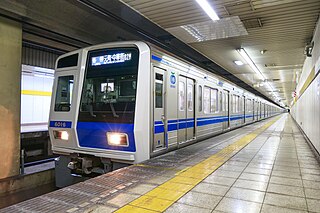
The Seibu Yūrakuchō Line is an underground railway line operated by the private railway operator Seibu Railway in Japan. The line links the Seibu Ikebukuro Line at Nerima Station with the Tokyo Metro Yūrakuchō Line and Tokyo Metro Fukutoshin Line at Kotake-Mukaihara Station in Nerima, Tokyo.
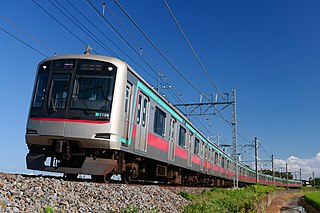
The Tokyu 5000 series is an electric multiple unit (EMU) train type operated by the private railway operator Tokyu Corporation since 2002 on many of its commuter lines in the Tokyo area of Japan.

The Tobu 9000 series is a DC electric multiple unit (EMU) commuter train type operated by the private railway operator Tobu Railway in Japan since 1981.

The Seibu 40000 series (西武40000系) is a commuter electric multiple unit (EMU) train type operated by the private railway operator Seibu Railway in Japan since March 2017. As of November 2023, a total of 20 ten-car trainsets have been built by Kawasaki Heavy Industries in Kobe from 2016, with the first trains entering service on 25 March 2017.

The Tōkyū Shin-Yokohama Line (東急新横浜線) is a commuter line operated by Tokyu Corporation connecting Hiyoshi Station on the Tōkyū Tōyoko and Meguro lines to Shin-Yokohama Station on the Sōtetsu Shin-Yokohama Line. Tōkyū has put its company name as a formal part of the line name, which is a second for Tōkyū, following the Tōkyū Tamagawa Line.
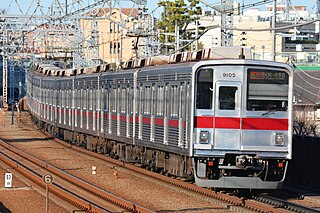
F Liner is the name for the fastest through service train among five railway companies: the Tobu Railway, Seibu Railway, Tokyo Metro, Tokyu Corporation and Yokohama Minatomirai Railway.

The Tokyo Metro 17000 series is a Japanese DC electric multiple unit (EMU) commuter train type operated by Tokyo Metro on the Yūrakuchō Line and Fukutoshin Line to replace the ageing Tokyo Metro 7000 series. It entered service on 21 February 2021.
The Tokyo Metro owns or uses the following types of rolling stock.
